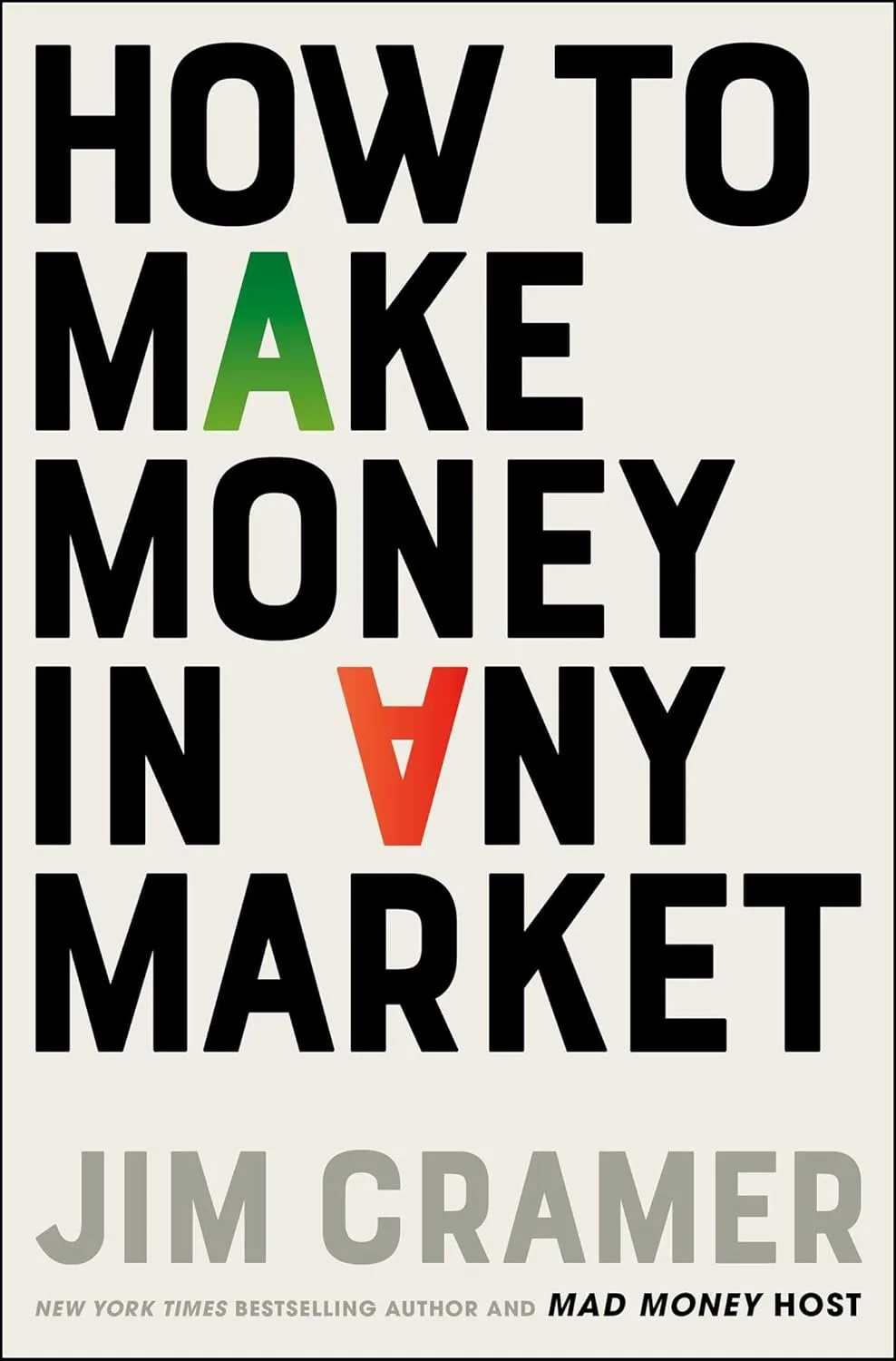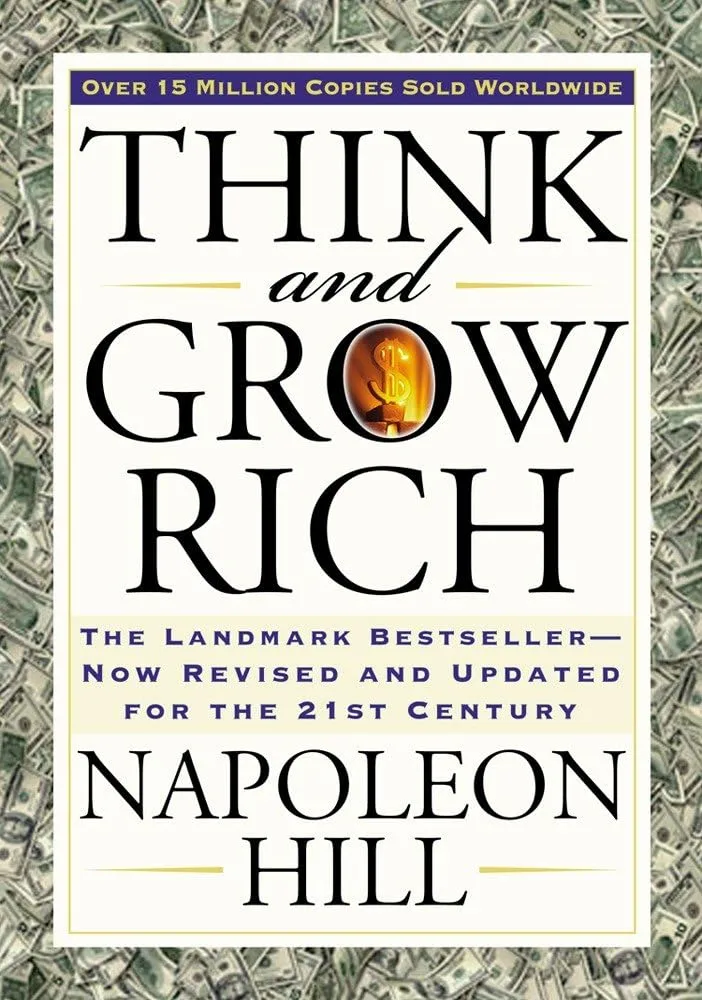Overview
How to Make Money in Any Market is Jim Cramer’s comprehensive guide to building wealth through strategic stock investing, regardless of market conditions. Drawing from decades of experience as a hedge fund manager, financial journalist, and host of CNBC’s “Mad Money,” Cramer demystifies the stock market and empowers everyday investors to take control of their financial futures.
This is a guide to overcoming your fear and world-weariness about Wall Street, showing you how to make bigger money with what you have, no matter how small, and how to do so in any market. The only way to get rich, Cramer argues, is to invest in growth and income stocks that he can help you identify.
Rather than relying solely on passive index fund investing, Cramer advocates for active stock selection combined with solid fundamental research. He breaks down complex market dynamics into actionable strategies that investors of all levels can understand and apply, whether facing bull markets, bear markets, or the uncertainty in between.
Key Takeaways
| Aspect | Details |
|---|---|
| Genre | Personal Finance, Investment Guide, Business, Self-Help |
| Publication Date | September 2025 |
| Publisher | Simon & Schuster |
| Format | Hardcover, ebook, audiobook (narrated by Cramer) |
| Author Credentials | Host of CNBC’s “Mad Money,” former hedge fund manager, bestselling author |
| Core Philosophy | Active stock selection beats passive index-only investing for wealth building |
| Target Investor | Everyday investors looking to grow wealth regardless of market conditions |
| Investment Approach | Combination of growth stocks, income stocks, and strategic stock selection |
| Market Perspective | Any market condition can be profitable with the right knowledge and strategy |
Book Structure
How to Make Money in Any Market is structured to take readers from fundamental understanding through practical application:
Part One: Understanding the Market
Cramer explains what the stock market really is, how it functions, and why stocks move up or down. This foundational section demystifies Wall Street jargon and builds reader confidence.
Part Two: Stock Selection Fundamentals
You need to learn how the stock market really works, what stocks actually mean, why they go up or down, and how you can find the right ones. This section covers identifying quality companies, understanding financial statements, and recognizing value.
Part Three: Growth vs. Income Stocks
Detailed exploration of growth stocks (companies with high potential for appreciation) versus income stocks (dividend-paying companies providing steady cash flow), and how to balance both in your portfolio.
Part Four: Market Conditions and Strategies
Specific strategies for bull markets, bear markets, sideways markets, and periods of high volatility. Cramer explains how to adjust your approach based on economic conditions.
Part Five: Index Funds and Beyond
Cramer acknowledges the role of index funds in your portfolio but argues they shouldn’t be your only strategy. This section explains how to use index funds appropriately while actively managing a portion of your portfolio.
Part Six: Risk Management and Psychology
Addresses the emotional and psychological aspects of investing, including managing fear, greed, and the temptation to panic during market downturns.
Part Seven: Practical Implementation
Step-by-step guidance on building and managing your portfolio, including position sizing, when to buy and sell, and how to track your investments.
About the Author
Jim Cramer is one of the most recognizable financial personalities in America. After twenty years building his reputation as a market expert, he became a household name through his energetic and passionate approach to teaching investors.
Professional Background:
- Host of CNBC’s “Mad Money” (since 2005)
- Co-host of CNBC’s “Squawk on the Street”
- Former hedge fund manager with impressive track record
- Co-founder of TheStreet.com, a financial news and services website
- Harvard College graduate (Class of 1977)
- Harvard Law School graduate
- Former reporter for various publications including the Los Angeles Herald Examiner
Previous Bestsellers:
- Jim Cramer’s Real Money: Sane Investing in an Insane World
- Jim Cramer’s Mad Money: Watch TV, Get Rich
- Jim Cramer’s Get Rich Carefully
- Jim Cramer’s Stay Mad for Life
Cramer’s unique blend of Wall Street expertise, teaching ability, and media presence makes him uniquely qualified to translate complex investment strategies into accessible advice for everyday investors.
Why This Book Resonates
Timely Market Uncertainty: Released during a period of economic volatility and uncertainty, the book addresses investors’ current anxieties about market conditions and provides actionable strategies.
Cramer’s Accessible Style: His energetic, no-nonsense approach makes investing feel less intimidating and more achievable for average people.
Challenges Passive-Only Narrative: While index investing has dominated recent investment advice, Cramer offers a contrarian view that empowers investors to take more control of their portfolios.
Practical Over Theoretical: Rather than academic theories, Cramer provides battle-tested strategies from his decades managing real money in real markets.
Overcoming Fear: The book directly addresses the psychological barriers that prevent people from investing, offering both encouragement and practical solutions.
Small Account Friendly: Emphasizes that you don’t need to be wealthy to start building wealth through strategic investing.
Media Platform Integration: Cramer’s daily presence on CNBC allows readers to see his strategies in action and continue their education beyond the book.
Ideal Audience
This book is perfect for:
- Beginning investors intimidated by the stock market but eager to start building wealth
- Index fund investors wanting to add active stock selection to their strategy
- Intermediate investors looking to refine their approach and improve returns
- “Mad Money” viewers who want to deepen their understanding of Cramer’s strategies
- Retail investors managing their own portfolios
- Career professionals building retirement wealth outside of 401(k)s
- Those with small accounts who believe they need more money to start investing
- Investors paralyzed by fear of market volatility or making mistakes
- People skeptical of Wall Street who want to understand it better
- Anyone burned by past investments looking for a more systematic approach
Not ideal for: Those seeking get-rich-quick schemes, day trading strategies, or cryptocurrency advice. This is about long-term wealth building through stock investing.
Memorable Quote
“The only way to get rich is to invest in growth and income stocks that I can help you identify. You just need to learn how the stock market really works, what stocks actually mean, why they go up or down, and how you can find the right ones.”
This quote encapsulates Cramer’s entire philosophy: wealth comes from knowledge and strategic stock selection, not from avoiding the market or relying exclusively on passive strategies. He positions himself as a teacher empowering readers with the tools they need to succeed.
Central Themes
| Theme | Exploration in the Book |
|---|---|
| Active vs. Passive Investing | While index funds have their place, true wealth building requires some active stock selection; balance is key |
| Market Psychology | Understanding your emotional responses to market movements and learning to invest rationally rather than emotionally |
| Stock Fundamentals Matter | Company quality, earnings, management, and business models determine long-term stock success more than market timing |
| Any Market Can Be Profitable | Bull, bear, or sideways markets all offer opportunities if you know what to look for and how to position yourself |
| Education Empowers Action | Knowledge defeats fear; understanding how markets work gives you confidence to invest strategically |
| Growth and Income Balance | Combining growth stocks (appreciation potential) with income stocks (dividend reliability) creates sustainable portfolios |
| Risk Management | Protecting capital is as important as growing it; diversification and position sizing prevent catastrophic losses |
| Start Small, Think Big | You don’t need massive capital to begin; consistent investing with small amounts compounds over time |
| Research Beats Guessing | Successful investing requires homework—understanding what you own and why you own it |
| Adapt to Conditions | Strategies that work in bull markets differ from bear market strategies; flexibility is essential |
Key Investment Strategies
The Cramer Stock Selection Method
Fundamental Analysis Focus:
- Understanding company earnings and growth trajectories
- Evaluating management quality and corporate strategy
- Assessing competitive advantages and market position
- Reading and interpreting financial statements
Identifying Growth Stocks: Characteristics of companies with high appreciation potential, typically showing strong revenue growth, innovative products or services, and expanding market share.
Income Stock Selection: How to find reliable dividend-paying stocks that provide steady cash flow while maintaining capital preservation.
Portfolio Construction:
- Diversification across sectors and market caps
- Position sizing to manage risk
- Balancing growth and income investments
- Using index funds appropriately within overall strategy
Market Timing Insights: While Cramer doesn’t advocate day trading, he explains how to recognize market conditions and adjust strategy accordingly—when to be aggressive, when to be defensive, and when to hold steady.
The Role of Index Funds: Cramer acknowledges index funds as useful portfolio components but argues they shouldn’t be your exclusive strategy. He explains how to use them as a foundation while actively managing a portion of your portfolio for enhanced returns.
FAQ
Q: Is this book for beginners or experienced investors? A: Both. Cramer explains fundamentals for beginners while offering insights that intermediate investors will find valuable for refining their strategies.
Q: Does Cramer really think anyone can beat the market? A: He believes that with proper education, research, and disciplined strategy, investors can select individual stocks that outperform index averages, especially when combined with index holdings.
Q: Do I need a lot of money to use these strategies? A: No. Cramer emphasizes that these strategies work regardless of account size, making them accessible to investors starting with small amounts.
Q: Is this just a recap of “Mad Money” episodes? A: No. While it draws on Cramer’s TV work, the book provides comprehensive, structured teaching that goes deeper than television segments allow.
Q: Does the book recommend specific stocks? A: While Cramer may use examples, the focus is on teaching you how to identify quality stocks yourself rather than providing a list to blindly follow.
Q: Is this about day trading or get-rich-quick strategies? A: No. This is about long-term wealth building through strategic stock investing, not speculative day trading.
Q: How does this differ from his previous books? A: This focuses specifically on succeeding in any market condition, emphasizing adaptability and resilience regardless of economic circumstances.
Q: Will this work in the current market environment? A: Cramer specifically designed this book to address current market uncertainties and volatility, providing strategies that work whether markets rise, fall, or move sideways.
Cramer’s Investment Philosophy
Core Principles:
- Knowledge Conquers Fear: Most people avoid the stock market because they don’t understand it. Education removes the fear barrier.
- Homework Pays: Successful investing requires research. You must understand what you own and why.
- Own, Don’t Trade: Cramer advocates owning quality stocks for the long term, not constant trading.
- Diversify Sensibly: Spread risk across sectors and company sizes without over-diversifying to the point of mediocrity.
- Respect Risk: Never invest money you can’t afford to lose. Use stop losses and position sizing to protect capital.
- Stay Disciplined: Emotional decisions lead to losses. Create and follow your investment plan systematically.
- Adapt and Evolve: Markets change. Successful investors adjust strategies as conditions shift.
- Index Plus Alpha: Use index funds as a foundation, then seek to add value through selective active management.
Practical Application Guide
Getting Started:
- Set up investment accounts (brokerage, IRA, etc.)
- Determine your risk tolerance and investment timeline
- Allocate capital between index funds and active stock selection
- Begin with companies you understand
Building Your Watchlist:
- Identify sectors showing strength or value
- Research individual companies within those sectors
- Evaluate fundamentals: earnings, growth, management, competitive position
- Start with a manageable number of stocks to follow
Making Purchases:
- Don’t try to perfectly time the market
- Consider dollar-cost averaging for larger positions
- Use limit orders rather than market orders
- Start with smaller positions as you build confidence
Portfolio Management:
- Review holdings regularly but don’t obsess daily
- Rebalance periodically to maintain target allocations
- Take profits on winners strategically
- Cut losses on mistakes rather than holding and hoping
- Keep adequate cash reserves for opportunities
Continuing Education:
- Follow company earnings reports
- Read business news from multiple sources
- Watch “Mad Money” for ongoing market commentary
- Join investing communities for discussion and learning
Critical Reception
Commercial Success:
- Bestselling personal finance release in its category
- Strong pre-orders indicating market demand for Cramer’s expertise
- Audiobook narrated by Cramer himself adds authenticity and engagement
Reader Response:
- Praised for accessibility and practical advice
- Appreciated for addressing current market anxieties
- Valued for balanced approach between passive and active investing
- Some critics note Cramer’s track record has been mixed
- Debate continues about whether average investors can consistently outperform indexes
Strengths:
- Clear, energetic writing style
- Practical strategies that can be implemented immediately
- Addresses psychological barriers to investing
- Balances theory with real-world application
- Encourages education and empowerment
Considerations:
- Active investing requires significant time and research
- Not everyone will successfully pick outperforming stocks
- Some strategies may seem too aggressive for conservative investors
- Cramer’s past predictions haven’t always been accurate
- Active management typically incurs higher costs than passive investing
The Index Fund Debate
Cramer’s stance on index funds represents a measured middle ground:
What He Agrees With:
- Index funds should be part of most portfolios
- Low costs and broad diversification are valuable
- Passive investing works for many people’s goals
Where He Differs:
- Index-only strategies may leave money on the table
- With education, investors can identify opportunities indexes miss
- Active selection of a portion of your portfolio can enhance returns
- Complete passivity means accepting average returns
His Recommended Approach: Use index funds as a foundation (perhaps 50-70% of portfolio) while actively managing the remainder, focusing on high-conviction opportunities that research reveals.
Final Thoughts
How to Make Money in Any Market delivers on its promise: practical, accessible guidance for building wealth through stock investing regardless of market conditions. Jim Cramer’s decades of experience shine through in his ability to explain complex concepts clearly and his genuine passion for teaching everyday investors to take control of their financial futures.
The book’s greatest strength is its empowerment message. Rather than telling readers the market is too complex or dangerous for them, Cramer insists that with proper education and disciplined strategy, anyone can become a successful investor. He doesn’t promise easy riches or foolproof systems, but he does provide the knowledge and tools needed to make informed investment decisions.
For readers intimidated by the stock market or frustrated with one-size-fits-all advice, this book offers a refreshing alternative. Cramer acknowledges that not everyone will want to actively manage stocks—and that’s fine—but for those willing to do the homework, he charts a clear path forward.
The balanced approach to active and passive investing represents evolved thinking in the investment community. Rather than dogmatically insisting on one approach or the other, Cramer advocates using both strategically, which will likely resonate with investors tired of the passive vs. active holy wars.
Critics will point to Cramer’s imperfect prediction record and studies showing few active managers consistently beat indexes. These are fair concerns. However, the book’s value lies not in following Cramer’s specific picks but in learning his methodology for analyzing companies and markets. Whether or not readers ultimately outperform indexes, they’ll understand their investments better and feel more confident managing their wealth.
For those willing to invest time in learning and research, How to Make Money in Any Market provides a comprehensive framework for navigating all market conditions. For those preferring simpler approaches, it still offers valuable context for understanding how markets work and making better-informed decisions about even passive investments.
Recommendation: Valuable for investors at all levels seeking to understand markets better and potentially enhance returns through selective active management. Best approached with realistic expectations about the work required and outcomes achievable, but offers genuine value for those willing to engage with the material seriously.
Key Terms Glossary
Growth Stocks: Companies expected to grow revenue and earnings faster than average, typically reinvesting profits rather than paying dividends
Income Stocks: Established companies paying regular dividends, providing steady cash flow to investors
Index Funds: Investment funds designed to track specific market indexes like the S&P 500
Diversification: Spreading investments across multiple stocks, sectors, or asset classes to reduce risk
Position Sizing: Determining how much capital to allocate to each investment
Stop Loss: Predetermined price at which you’ll sell a stock to limit losses
Dollar-Cost Averaging: Investing fixed amounts regularly regardless of market conditions
Fundamental Analysis: Evaluating companies based on financial statements, management, competitive position, and business model
Links
- More Summaries
- Barnes & Noble
- Simon & Schuster Publisher Page
- Audiobook on Audible (narrated by Jim Cramer)
- CNBC Mad Money
- TheStreet.com







